Note
Access to this page requires authorization. You can try signing in or changing directories.
Access to this page requires authorization. You can try changing directories.
APPLIES TO:  Azure Data Factory
Azure Data Factory  Azure Synapse Analytics
Azure Synapse Analytics
Tip
Try out Data Factory in Microsoft Fabric, an all-in-one analytics solution for enterprises. Microsoft Fabric covers everything from data movement to data science, real-time analytics, business intelligence, and reporting. Learn how to start a new trial for free!
In this tutorial, you use the Azure Data Factory user interface (UX) to create a pipeline that copies and transforms data from an Azure Data Lake Storage (ADLS) Gen2 source to an ADLS Gen2 sink using mapping data flow. The configuration pattern in this tutorial can be expanded upon when transforming data using mapping data flow
This tutorial is meant for mapping data flows in general. Data flows are available both in Azure Data Factory and Synapse Pipelines. If you're new to data flows in Azure Synapse Pipelines, follow Data Flow using Azure Synapse Pipelines.
In this tutorial, you do the following steps:
- Create a data factory.
- Create a pipeline with a Data Flow activity.
- Build a mapping data flow with four transformations.
- Test run the pipeline.
- Monitor a Data Flow activity
Prerequisites
- Azure subscription. If you don't have an Azure subscription, create a free Azure account before you begin.
- Azure Data Lake Storage Gen2 account. You use ADLS storage as a source and sink data stores. If you don't have a storage account, see Create an Azure storage account for steps to create one.
- Download MoviesDB.csv here. To retrieve the file from GitHub, copy the contents to a text editor of your choice to save locally as a .csv file. Upload the file to your storage account in a container named 'sample-data'.
Create a data factory
In this step, you create a data factory and open the Data Factory UX to create a pipeline in the data factory.
Open Microsoft Edge or Google Chrome. Currently, Data Factory UI is supported only in the Microsoft Edge and Google Chrome web browsers.
On the top menu, select Create a resource > Analytics > Data Factory :
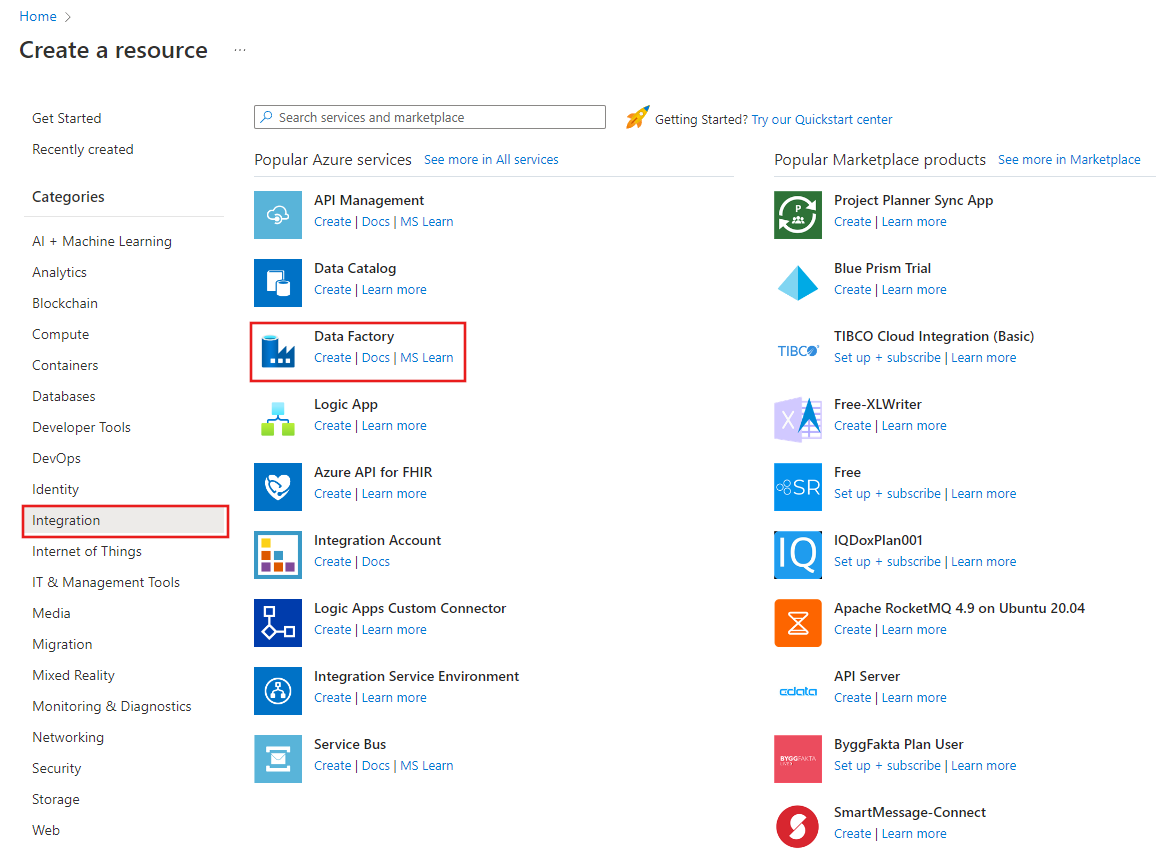
On the New data factory page, under Name, enter ADFTutorialDataFactory.
The name of the Azure data factory must be globally unique. If you receive an error message about the name value, enter a different name for the data factory. (for example, yournameADFTutorialDataFactory). For naming rules for Data Factory artifacts, see Data Factory naming rules.
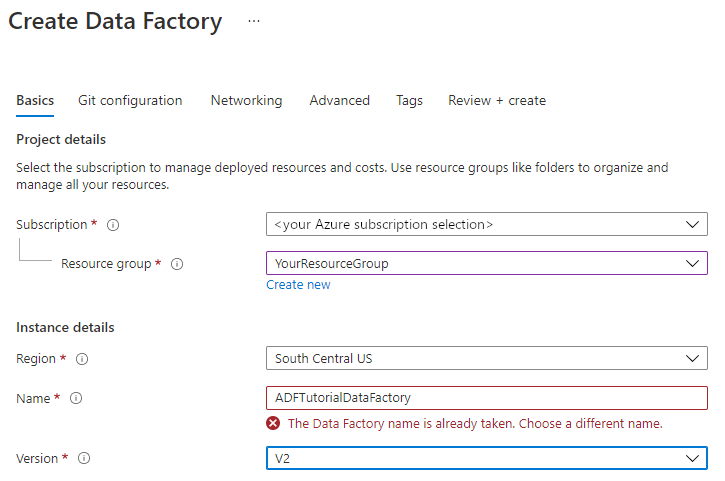
Select the Azure subscription in which you want to create the data factory.
For Resource Group, take one of the following steps:
Select Use existing, and select an existing resource group from the drop-down list.
Select Create new, and enter the name of a resource group.
To learn about resource groups, see Use resource groups to manage your Azure resources.
Under Version, select V2.
Under Region, select a location for the data factory. Only locations that are supported are displayed in the drop-down list. Data stores (for example, Azure Storage and SQL Database) and computes (for example, Azure HDInsight) used by the data factory can be in other regions.
Select Review + Create and then select Create.
After the creation is finished, you see the notice in Notifications center. Select Go to resource to navigate to the Data factory page.
Select Launch studio to launch the Data Factory studio in a separate tab.
Create a pipeline with a Data Flow activity
In this step, you create a pipeline that contains a Data Flow activity.
On the home page of Azure Data Factory, select Orchestrate.
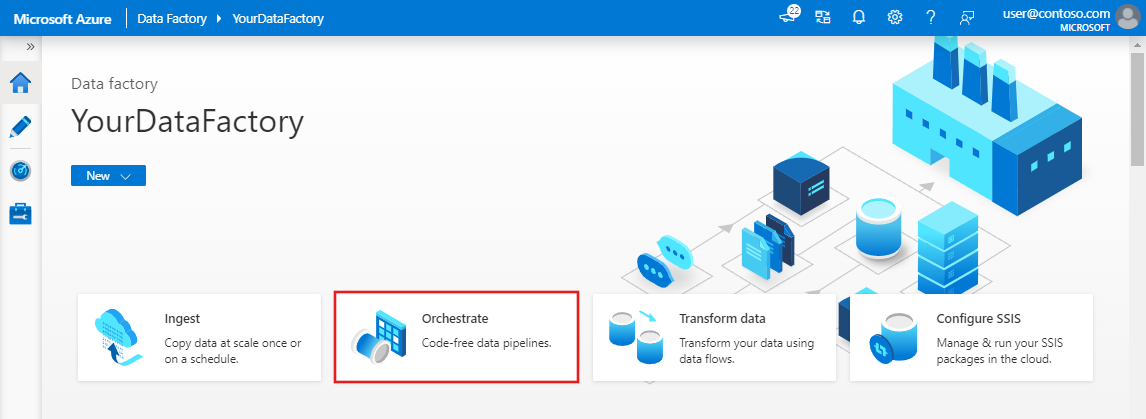
Now a window is open for a new pipeline. In the General tab for the pipeline properties, enter TransformMovies for Name of the pipeline.
In the Activities pane, expand the Move and Transform accordion. Drag and drop the Data Flow activity from the pane to the pipeline canvas.
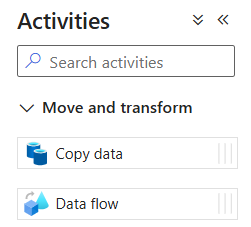
Name your data flow activity DataFlow1.
In the top bar of the pipeline canvas, slide the Data Flow debug slider on. Debug mode allows for interactive testing of transformation logic against a live Spark cluster. Data Flow clusters take 5-7 minutes to warm up and users are recommended to turn on debug first if they plan to do Data Flow development. For more information, see Debug Mode.

Build transformation logic in the data flow canvas
In this step, you build a data flow that takes the moviesDB.csv in ADLS storage and aggregates the average rating of comedies from 1910 to 2000. You then write this file back to the ADLS storage.
In the panel below the canvas, go to the Settings of your data flow activity and select New, located beside data flow field. This opens the dataflow canvas.
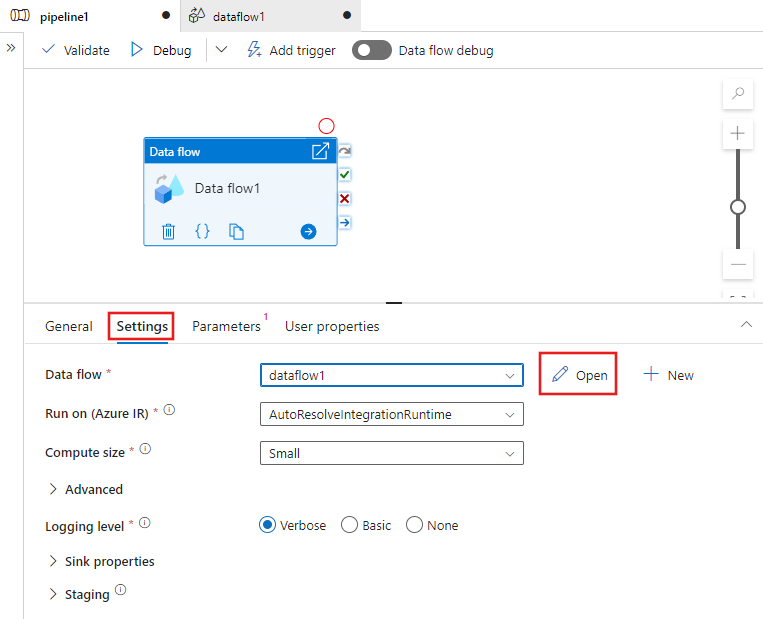
In the Properties pane under General, name your data flow: TransformMovies.
In the data flow canvas, add a source by selecting the Add Source box.

Name your source MoviesDB. Select New to create a new source dataset.

Choose Azure Data Lake Storage Gen2. Select Continue.

Choose DelimitedText. Select Continue.
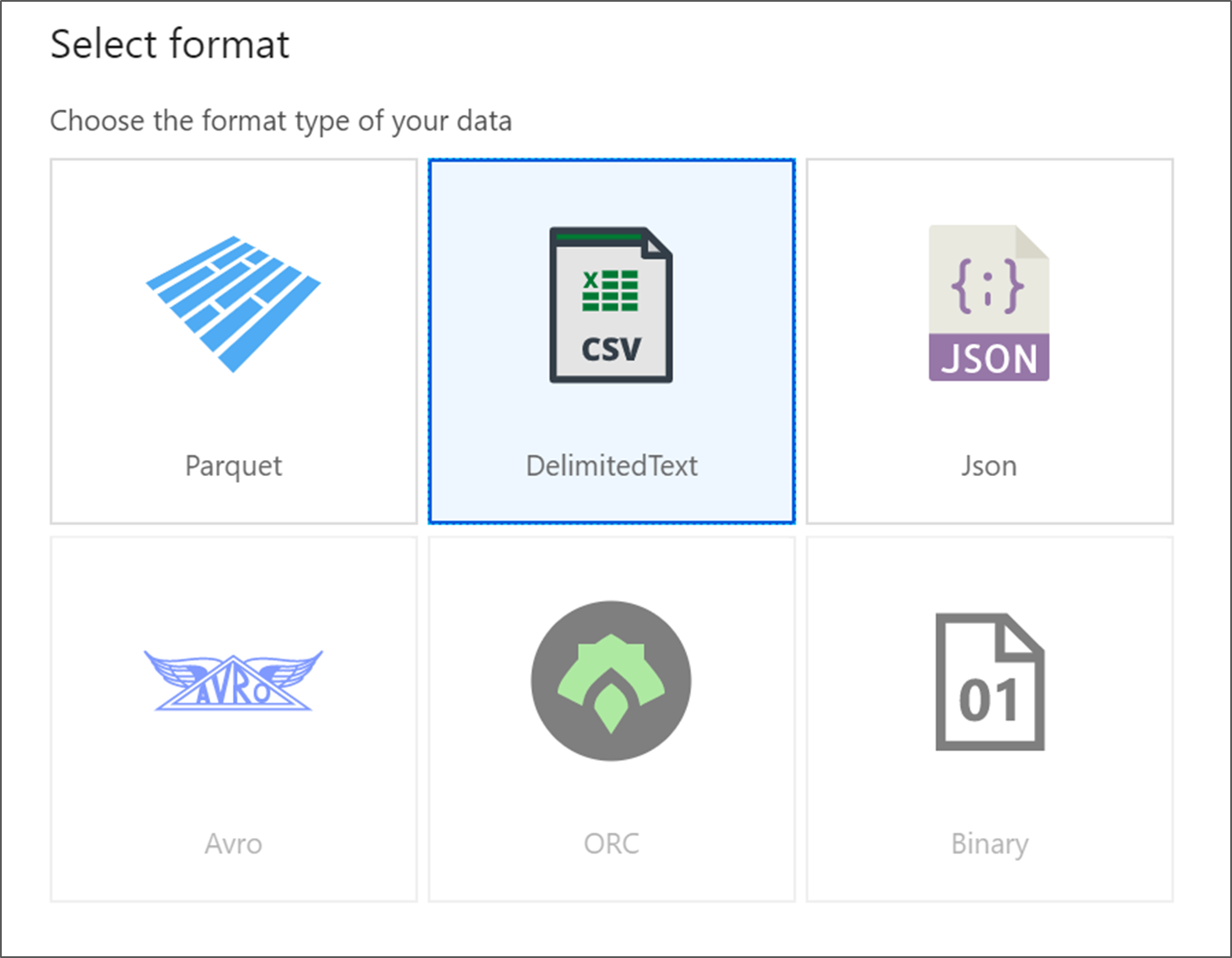
Name your dataset MoviesDB. In the linked service dropdown, choose New.

In the linked service creation screen, name your ADLS gen2 linked service ADLSGen2 and specify your authentication method. Then enter your connection credentials. In this tutorial, we're using Account key to connect to our storage account. You can select Test connection to verify your credentials were entered correctly. Select Create when finished.

Once you're back at the dataset creation screen, enter where your file is located under the File path field. In this tutorial, the file moviesDB.csv is located in container sample-data. As the file has headers, check First row as header. Select From connection/store to import the header schema directly from the file in storage. Select OK when done.

If your debug cluster has started, go to the Data Preview tab of the source transformation and select Refresh to get a snapshot of the data. You can use data preview to verify your transformation is configured correctly.

Next to your source node on the data flow canvas, select the plus icon to add a new transformation. The first transformation you're adding is a Filter.

Name your filter transformation FilterYears. Select the expression box next to Filter on and then Open expression builder. Here you specify your filtering condition.

The data flow expression builder lets you interactively build expressions to use in various transformations. Expressions can include built-in functions, columns from the input schema, and user-defined parameters. For more information on how to build expressions, see Data Flow expression builder.
In this tutorial, you want to filter movies of genre comedy that came out between the years 1910 and 2000. As year is currently a string, you need to convert it to an integer using the
toInteger()function. Use the greater than or equals to (>=) and less than or equals to (<=) operators to compare against literal year values 1910 and 2000. Union these expressions together with the and (&&) operator. The expression comes out as:toInteger(year) >= 1910 && toInteger(year) <= 2000To find which movies are comedies, you can use the
rlike()function to find pattern 'Comedy' in the column genres. Union therlikeexpression with the year comparison to get:toInteger(year) >= 1910 && toInteger(year) <= 2000 && rlike(genres, 'Comedy')If you have a debug cluster active, you can verify your logic by selecting Refresh to see expression output compared to the inputs used. There's more than one right answer on how you can accomplish this logic using the data flow expression language.

Select Save and Finish once you're done with your expression.
Fetch a Data Preview to verify the filter is working correctly.

The next transformation you'll add is an Aggregate transformation under Schema modifier.

Name your aggregate transformation AggregateComedyRatings. In the Group by tab, select year from the dropdown to group the aggregations by the year the movie came out.

Go to the Aggregates tab. In the left text box, name the aggregate column AverageComedyRating. Select the right expression box to enter the aggregate expression via the expression builder.

To get the average of column Rating, use the
avg()aggregate function. As Rating is a string andavg()takes in a numerical input, we must convert the value to a number via thetoInteger()function. This is expression looks like:avg(toInteger(Rating))Select Save and Finish when done.

Go to the Data Preview tab to view the transformation output. Notice only two columns are there, year and AverageComedyRating.

Next, you want to add a Sink transformation under Destination.

Name your sink Sink. Select New to create your sink dataset.
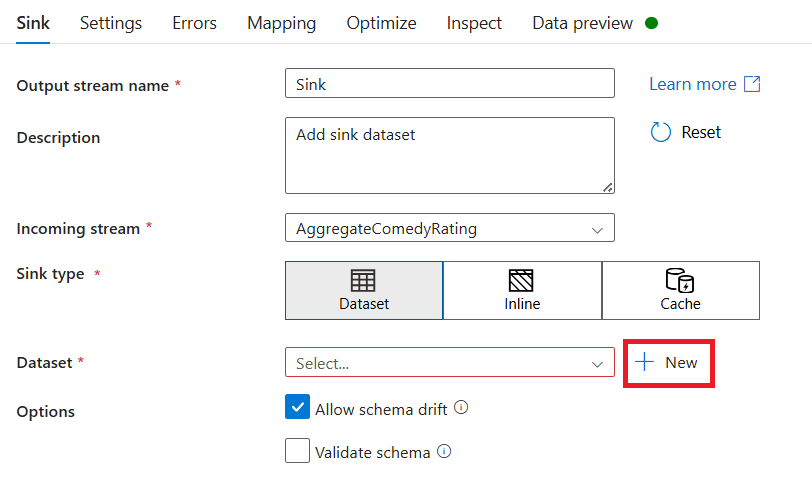
Choose Azure Data Lake Storage Gen2. Select Continue.

Choose DelimitedText. Select Continue.

Name your sink dataset MoviesSink. For linked service, choose the ADLS gen2 linked service you created in step 6. Enter an output folder to write your data to. In this tutorial, we're writing to folder 'output' in container 'sample-data'. The folder doesn't need to exist beforehand and can be dynamically created. Set First row as header as true and select None for Import schema. Select Finish.

Now you've finished building your data flow. You're ready to run it in your pipeline.
Running and monitoring the Data Flow
You can debug a pipeline before you publish it. In this step, you're going to trigger a debug run of the data flow pipeline. While data preview doesn't write data, a debug run writes data to your sink destination.
Go to the pipeline canvas. Select Debug to trigger a debug run.

Pipeline debug of Data Flow activities uses the active debug cluster but still take at least a minute to initialize. You can track the progress via the Output tab. Once the run is successful, hover over the run and select the eyeglasses icon to open the monitoring pane.

In the monitoring pane, select the Stages button to see the number of rows and time spent in each transformation step.
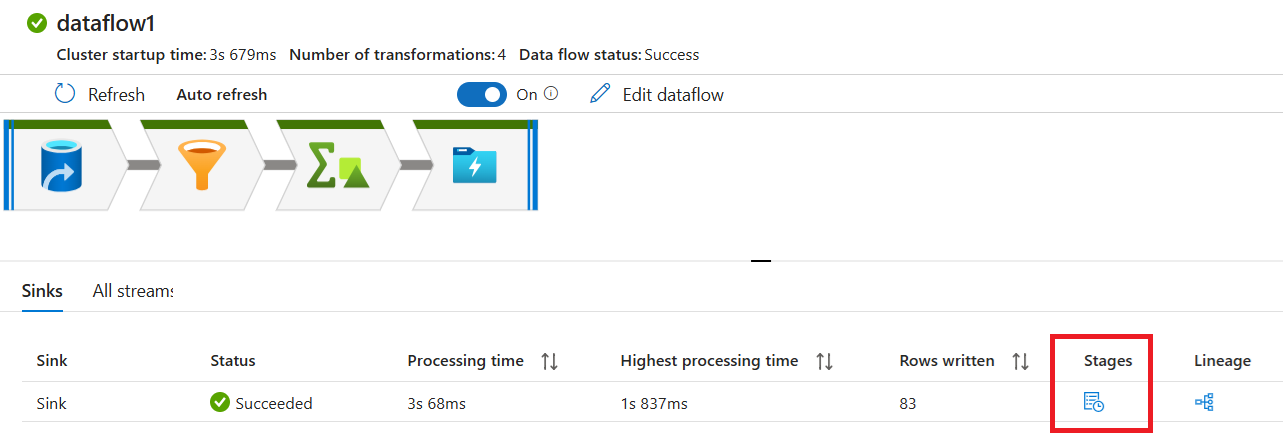

Select a transformation to get detailed information about the columns and partitioning of the data.
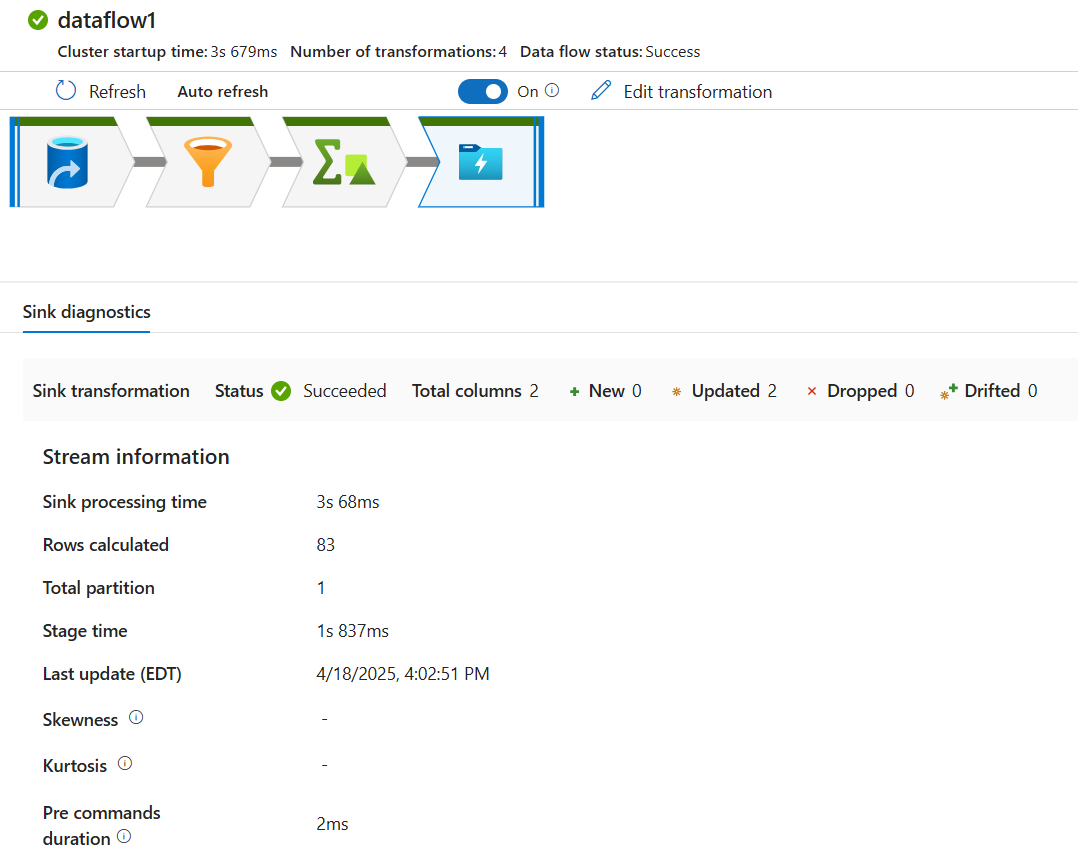
If you followed this tutorial correctly, you should have written 83 rows and 2 columns into your sink folder. You can verify the data is correct by checking your blob storage.
Related content
The pipeline in this tutorial runs a data flow that aggregates the average rating of comedies from 1910 to 2000 and writes the data to ADLS. You learned how to:
- Create a data factory.
- Create a pipeline with a Data Flow activity.
- Build a mapping data flow with four transformations.
- Test run the pipeline.
- Monitor a Data Flow activity
Learn more about the data flow expression language.